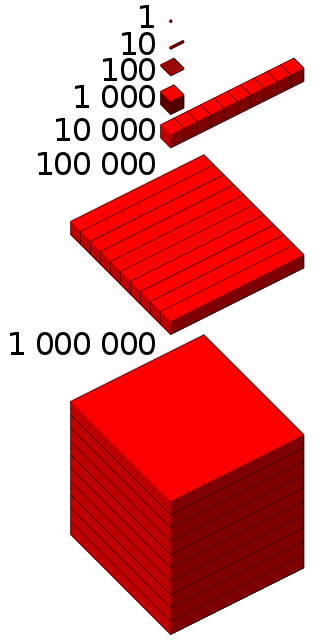Related Research Articles
1000 or one thousand is the natural number following 999 and preceding 1001. In most English-speaking countries, it can be written with or without a comma or sometimes a period separating the thousands digit: 1,000.
300 is the natural number following 299 and preceding 301.
500 is the natural number following 499 and preceding 501.
700 is the natural number following 699 and preceding 701.
600 is the natural number following 599 and preceding 601.
2000 is a natural number following 1999 and preceding 2001.
10,000 is the natural number following 9,999 and preceding 10,001.
6000 is the natural number following 5999 and preceding 6001.

1,000,000, or one thousand thousand, is the natural number following 999,999 and preceding 1,000,001. The word is derived from the early Italian millione, from mille, "thousand", plus the augmentative suffix -one.

1,000,000,000 is the natural number following 999,999,999 and preceding 1,000,000,001. With a number, "billion" can be abbreviated as b, bil or bn.
100,000 (one hundred thousand) is the natural number following 99,999 and preceding 100,001. In scientific notation, it is written as 105.
216 is the natural number following 215 and preceding 217. It is a cube, and is often called Plato's number, although it is not certain that this is the number intended by Plato.
10,000,000 is the natural number following 9,999,999 and preceding 10,000,001.
100,000,000 is the natural number following 99,999,999 and preceding 100,000,001.
20,000 is the natural number that comes after 19,999 and before 20,001.
30,000 is the natural number that comes after 29,999 and before 30,001.
40,000 is the natural number that comes after 39,999 and before 40,001. It is the square of 200.
50,000 is the natural number that comes after 49,999 and before 50,001.
60,000 is the natural number that comes after 59,999 and before 60,001. It is a round number. It is the value of (75025).
307 is the natural number following 306 and preceding 308.
References
- ↑ Sloane, N. J. A. (ed.). "SequenceA001246(Squares of Catalan numbers)". The On-Line Encyclopedia of Integer Sequences . OEIS Foundation.
- ↑ Sloane, N. J. A. (ed.). "SequenceA036449(Values square, differences triangular)". The On-Line Encyclopedia of Integer Sequences . OEIS Foundation.
- ↑ Sloane, N. J. A. (ed.). "SequenceA000988(Number of one-sided polyominoes with n cells)". The On-Line Encyclopedia of Integer Sequences . OEIS Foundation.
- ↑ Sloane, N. J. A. (ed.). "SequenceA023108(A023108)". The On-Line Encyclopedia of Integer Sequences . OEIS Foundation.
- ↑ Gabai, Hyman; Coogan, Daniel (1969). "On palindromes and palindromic primes". Mathematics Magazine. 42 (5): 252–254. doi:10.2307/2688705. JSTOR 2688705. MR 0253979.